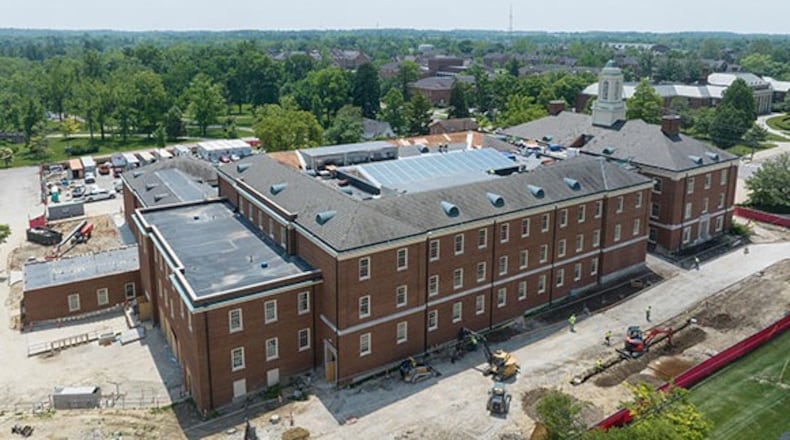Classes open on Aug. 25, with freshmen moving in Aug. 22, and some major campus construction and renovation projects will still be in progress, said Cody Powell, associate vice president of facilities planning & operations for Miami.
Work on Bachelor Hall, which stands at the eastern entrance of the campus at the corner of Ohio 73 and South Patterson Avenue, remains on schedule for the 46-year-old building used by many of Miami’s students, said Powell.
“Rather than two buildings (previously) connected by an outdoor space, the renovated building will be connected all under one roof and have a large space essential for impromptu gatherings and collaboration,” Powell said.
“As one of Miami’s most heavily used classroom buildings, this renovation will impact almost all Miami students as the facility supports a broad range of coursework.”
Other major projects include extensive underground drilling around Millett Hall as an extension of the university’s already widely installed geothermal heating and cooling system.
Credit: Jeff Sabo
Credit: Jeff Sabo
Started in 2024 and scheduled to be completed in the coming late fall, final drilling was completed in May, said Powell, for the North Chiller Plant Geothermal Conversion project.
The project will continue to impact some student parking, nearby roadways and sidewalks adjacent to the Millett sports arena and office complex along the campus’ northern border.
The next phase of the project involves converting the equipment in the North Chiller Plant – formerly known as Billings Hall - to support simultaneous heating and cooling and geothermal exchange, he said.
“The North Campus Geothermal Conversion project is one of the major projects as we near completion of our long-time Utility Master Plan. Not only will this project contribute in a major way toward Miami’s goal of carbon neutrality by 2040 but is critical to our strategy in managing our energy consumption and cost of operations.”
Miami officials said by 2026, 72% of Miami Oxford’s buildings will have been converted to geothermal temperature control.
And work will continue into the fall on the school’s $5 million solar power project that is the largest in the school’s history.
Once the solar panel installations in the field, which was the site of the former Thomson Hall next to Ohio 73, is complete and connected to the electric grid, the two solar arrays are expected to start producing more than 2,000 megawatt hours of electricity annually, said Project Director Joel Fellman, electrical engineer and project manager for Miami’s physical facilities department.
About the Author

